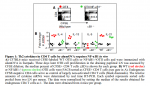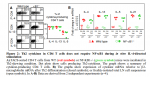Karine SERRE, PhD
IMMUNOLOGIST
Latest Posts
21/01/2016
Psoriasis is an autoimmune disease and NOT a chronic inflammatory disease!12/05/2015
CALL For PAPERS: “Innate T Cell Development and Functions in Immune Diseases”28/08/2014
XL Annual Meeting of the Sociedade Portuguesa de Imunologia 13-15th October 201413/04/2013
Beginnings of breaking down the differentiation program of innate IL-17-production27/01/2013
The improbable trio NKG2D – γδ T cells – IgE!!NF-kB1
NF-kB1, a key regulator of Th2 cytokine induction in CD4 T cells in vivo, is redundant for IL-4-directed induction of IL-4 in vitro
Several transcription factors are involved in Th2 commitment. GATA-3 is essential for the differentiation and maintenance of Th2 cells (1). c-Maf directly regulates IL-4 production (2) and growing evidence indicates that NF-kB members can participate in translation of the Il-4 gene. NF-kB1(p50) (3) and c-Rel (4), which can combine to form heterodimers, are implicated in the pathogenesis of asthma and in resistance to intestinal helminth infection (5). RelA(p65), also forms heterodimers with NF-kB1 and binds to the IL-4 promoter (6). Despite the importance of Th2 cells, there are still gaps in our understanding of how the expression of the transcription factors lead to the emergence of Th2 cells in vivo.
The requirement for transcription factors during Th2 differentiation was assessed using the NF-kB1-/-mice. These are unable to mount Th2 responses inducing allergic airways disease (3). By contrast, it is unclear whether NF-kB1 in CD4 T cells is needed for the Th2-response induced by alum-precipitated proteins. We have generated ovalbumin (OVA)-specific CD4 (OTII) T cells deficient in NF-kB1 and assessed their response to alum-precipitated OVA (alumOVA).
NF-kB1-/-OTII cells fail to upregulate Th2-cytokines in response to alumOVA
To test the role of NF-kB1 in Th2 induction by alumOVA WT mice received CFSE-labeled OTII or NF-kB1-/-OTII cells, and were immunized with alumOVA in both footpads. Both OTII and NF-kB1-/-OTII cells in the draining popliteal LN have divided to the same extent 3 days after immunization, with some cells completing 7 or more divisions (Fig. 1A).  This is consistent with a report showing NF-kB1 is not involved in early events of proliferation (3) although this has been questioned (7). After 3 days OTII cells expressed 100 fold more IL-4 and 50 fold more IL-13 mRNA than the largely non-OVA-specific and hence non-responding endogenous CD4 T cells (Fig. 1B). Changes in mRNA expression closely reflect cytokine secretion (8-10). By contrast, NF-kB1-/-OTII cells produced little or no IL-4 or IL-13 mRNA in response to alumOVA (Fig. 1B). We confirm that IL-5 mRNA is not induced in CD4 T cells responding to alumOVA in LN (10, 11). Significantly, the NF-kB1-/-OTII cells still upregulated IL-21 mRNA, a feature of follicular T helper cells. Thus, NF-kB1-/-OTII cells have selectively impaired differentiation into Th2 cells in response to alumOVA.
This is consistent with a report showing NF-kB1 is not involved in early events of proliferation (3) although this has been questioned (7). After 3 days OTII cells expressed 100 fold more IL-4 and 50 fold more IL-13 mRNA than the largely non-OVA-specific and hence non-responding endogenous CD4 T cells (Fig. 1B). Changes in mRNA expression closely reflect cytokine secretion (8-10). By contrast, NF-kB1-/-OTII cells produced little or no IL-4 or IL-13 mRNA in response to alumOVA (Fig. 1B). We confirm that IL-5 mRNA is not induced in CD4 T cells responding to alumOVA in LN (10, 11). Significantly, the NF-kB1-/-OTII cells still upregulated IL-21 mRNA, a feature of follicular T helper cells. Thus, NF-kB1-/-OTII cells have selectively impaired differentiation into Th2 cells in response to alumOVA.
NF-kB1 is redundant for IL-4-directed Th2 polarization in vitro
Having established a key role for NF-kB1 in CD4 T cells responding to alumOVA for Th2-cytokine induction in vivo we sought to determine the dependency in NF-kB1 of CD4 T cells cultured in Th2-skewing conditions in vitro.
Previous in vitro studies have reported that NF-kB1-/-CD4 T cells cultured under Th2 polarizing conditions or WT CD4 T cells with the NF-kB1 inhibitor SN50 have markedly impaired IL-13 and IL-5 production, but the effect on IL-4 induction was less drastic (12). We have re-investigated the role of NF-kB1 in CD4 T cells during the in vitro IL-4-directed Th2-differentiation.
Polyclonal CD4 T cells were FACS-sorted from WT and NF-kB1-/- mice and subjected to anti-CD3 and CD28 stimulation in vitro in the presence of IL-4 plus anti-IFN-g and anti-IL-12. NF-kB1-/-CD4 T cells secreted IL-4, IL-13 and IL-5 to levels similar to those of WT CD4 T cells (Fig. 2A). Consistently IL-4, IL-13, IL-5 and IL-21 mRNA were also upregulated independently of NF-kB1 in the in vitro response (Fig. 2B).
Thus, in our hands, NF-kB1 is not required in CD4 T cells during Th2 cell differentiation induced in the presence of IL-4 in vitro. One possibility to explain the discrepancy between our results and the study from Das and colleagues (12) is that NF-kB1 is involved in CD4 T cell survival (13). While we performed intracellular FACS staining on day 5 to detect cytokine production, Das and Colleagues have measured cytokine secretion by ELISA on day 8. It is therefore plausible that defect in NF-kB1 affects CD4 T cell survival more consequently at day 8 than 5.
Conclusion
These results exemplify the major differences in the regulation of Th2 cytokines in vitro and in vivo. In this respect, we and others have previously shown that even though IL-4 directs Th2 polarization in vitro it is dispensable in response to alum-precipitated proteins in vivo (14, 15). Yet the signaling pathway that operates in vivo is still poorly understood. Our results indicate NF-kB1 a missing link in the search for mechanistic differences between these responses.
References:
1. Pai, S. Y., M. L. Truitt, and I. C. Ho. 2004. GATA-3 deficiency abrogates the development and maintenance of T helper type 2 cells. Proc Natl Acad Sci U S A 101:1993-1998.
2. Kim, J. I., I. C. Ho, M. J. Grusby, and L. H. Glimcher. 1999. The transcription factor c-Maf controls the production of interleukin-4 but not other Th2 cytokines. Immunity 10:745-751.
3. Yang, L., L. Cohn, D. H. Zhang, R. Homer, A. Ray, and P. Ray. 1998. Essential role of nuclear factor kappaB in the induction of eosinophilia in allergic airway inflammation. J Exp Med 188:1739-1750.
4. Donovan, C. E., D. A. Mark, H. Z. He, H. C. Liou, L. Kobzik, Y. Wang, G. T. De Sanctis, D. L. Perkins, and P. W. Finn. 1999. NF-kappa B/Rel transcription factors: c-Rel promotes airway hyperresponsiveness and allergic pulmonary inflammation. J Immunol 163:6827-6833.
5. Artis, D., S. Shapira, N. Mason, K. M. Speirs, M. Goldschmidt, J. Caamano, H. C. Liou, C. A. Hunter, and P. Scott. 2002. Differential requirement for NF-kappa B family members in control of helminth infection and intestinal inflammation. J Immunol 169:4481-4487.
6. Li-Weber, M., M. Giasi, and P. H. Krammer. 1998. Involvement of Jun and Rel proteins in up-regulation of interleukin-4 gene activity by the T cell accessory molecule CD28. J Biol Chem 273:32460-32466.
7. Artis, D., K. Speirs, K. Joyce, M. Goldschmidt, J. Caamano, C. A. Hunter, and P. Scott. 2003. NF-kappa B1 is required for optimal CD4+ Th1 cell development and resistance to Leishmania major. J Immunol 170:1995-2003.
8. Serre, K., E. Mohr, K. M. Toellner, A. F. Cunningham, R. Bird, M. Khan, and I. C. Maclennan. 2009. Early simultaneous production of intranodal CD4 Th2 effectors and recirculating rapidly responding central-memory-like CD4 T cells. Eur J Immunol 39:1573–1586.
9. Smith, K. M., J. M. Brewer, C. M. Rush, J. Riley, and P. Garside. 2004. In vivo generated Th1 cells can migrate to B cell follicles to support B cell responses. J Immunol 173:1640-1646.
10. Serre, K., E. Mohr, F. Gaspal, P. J. Lane, R. Bird, A. F. Cunningham, and I. C. MacLennan. 2010. IL-4 directs both CD4 and CD8 T cells to produce Th2 cytokines in vitro, but only CD4 T cells produce these cytokines in response to alum-precipitated protein in vivo. Mol Immunol In press.
11. Serre, K., E. Mohr, K. M. Toellner, A. F. Cunningham, S. Granjeaud, R. Bird, and I. C. MacLennan. 2008. Molecular differences between the divergent responses of ovalbumin-specific CD4 T cells to alum-precipitated ovalbumin compared to ovalbumin expressed by Salmonella. Mol Immunol 45:3558-3566.
12. Das, J., C. H. Chen, L. Yang, L. Cohn, P. Ray, and A. Ray. 2001. A critical role for NF-kappa B in GATA3 expression and TH2 differentiation in allergic airway inflammation. Nat Immunol 2:45-50.
13. Sriskantharajah, S., M. P. Belich, S. Papoutsopoulou, J. Janzen, V. Tybulewicz, B. Seddon, and S. C. Ley. 2009. Proteolysis of NF-kappaB1 p105 is essential for T cell antigen receptor-induced proliferation. Nat Immunol 10:38-47.
14. Cunningham, A. F., K. Serre, K. M. Toellner, M. Khan, J. Alexander, F. Brombacher, and I. C. MacLennan. 2004. Pinpointing IL-4-independent and IL-4-influenced acquisition and maintenance of Th2 activity by CD4 T cells. Eur J Immunol 34:686-694.
15. Brewer, J. M., M. Conacher, C. A. Hunter, M. Mohrs, F. Brombacher, and J. Alexander. 1999. Aluminium hydroxide adjuvant initiates strong antigen-specific Th2 responses in the absence of IL-4- or IL-13-mediated signaling. J Immunol 163:6448-6454.
